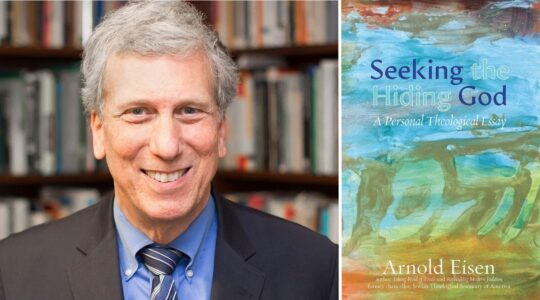Financial advisers agree that we should diversify our investments. “Spread the money around,” we’re told, “don’t put all your eggs in one basket.” Yet when it comes to investing in the Jewish future, our largest sources of wealth are doing the opposite of what they preach.
Philanthropists, foundations and federations are so focused on engaging young Jews, fearful that we’ll lose them in terms of Jewish affiliation, marriage and identity, that it is rare to find support for any project geared toward reaching Jews over 40.
Several years ago a Jewish Funders Network study asked nearly 200 funders and foundations to describe the primary target of their giving. Of the 21 categories listed on the survey, only one — social services for the elderly — referred to a specific age cohort older than young adults.
Isn’t it possible that in our zeal to attract one significant group, we’re making a mistake by overlooking the others?
At conferences and meetings in the Jewish community, locally and around the country, I find that whatever the political viewpoint or religious denomination of the sponsors, the most urgent question posed about sustaining American Jewish life in the 21st century is: How can we reach, connect to, captivate and hold our youth — particularly the Millennials (defined as those reaching young adulthood around the year 2000) — before it’s too late?
It’s a vital question, and believe me, I understand the concern. It shouldn’t have taken the recent Pew study on American Jewish identity to alert us to the problem. Any number of surveys of American Jewry of late, consistent with the results of studies of American society in general, reflect a move away from religious observance (while those who keep the faith increasingly are drawn to fundamentalism). There is also a move away from a sense of the community and the collective, and a strong shift toward individualism. In addition, Millennials are marrying later and having fewer children.
For the country as a whole, it’s a trend. For the Jewish community, it’s a potential disaster.
Judaism is all about Clal Yisrael, Jewish peoplehood. We need 10 to pray and we need a sense of collective responsibility to connect us as a people around the world. For thousands of years it has been our religion and our love of Israel — the land, the people, the history and the aspiration of a messianic future — that united us. Now those threads that bind us together are fraying, and many in this generation are averse to joining — whether it’s a synagogue or organization. And they’re finding Israel more confusing, if not embarrassing, than inspiring.
So yes, I praise the efforts to double down and explore creative ways to reach young Jews where they’re at, and I have seen the success of our boldest experiment, Birthright Israel, in bringing hundreds of thousands of 18- to 26-year-olds to experience Israel first-hand.
But too little creative funding is aimed at the interests and needs of the rest of us.
Learning From The Mormons
Support the New York Jewish Week
Our nonprofit newsroom depends on readers like you. Make a donation now to support independent Jewish journalism in New York.
Consider for a moment the approach and success of the Mormon Church. On the surface, American Mormons and Jews have much in common. Each has about the same small percentage of the American population, with higher levels of education and income than most other religious groups. And we have many shared values, especially in terms of family and education. But while the Jewish birthrate is declining, the Mormons’ rate is growing rapidly, with a strong emphasis on service to the church (its leadership is lay, not professional), strong intergenerational bonds, early marriage and large families.
What’s more, they have a remarkable 85 percent in-marriage rate, and their young adults have the highest participation in church life of any group.
So what are the Mormons doing that we can learn from?
Michelle Shain, a research associate in modern Jewish studies at Brandeis University who is working on a doctoral dissertation on fertility and American Jews, asked herself that question. One observation she offered is that Mormon leaders put special emphasis on engaging their teens, starting in junior high school, in serious conversations about church beliefs and goals, including sexual ethics and family values. Many of their youth aspire to serve for two years, without pay, at age 18 (for men) and 19 (for women), missionizing around the world and doing service projects for the poor.
Surely part of the Mormons’ success in creating high-level, engaging opportunities for education, humanitarian service and social interaction for young men and women in their 20s stems from the groundwork laid in engaging them in their early and mid-teens. That’s precisely the age — after bar and bat mitzvah — when Jewish boys and girls disappear from the communal map.
Starting Jewish engagement programs during the millennial years “is getting a late start,” observes Yossi Prager, executive director for North America of the Avi Chai Foundation, which focuses its efforts on Jewish day school and summer camp experiences.
Neglecting The Boomers
While early to mid-teen years is one age range we should be focusing on, another, at the upper end, is pre- and post-retirement. Many of those are the Baby Boomers (born between 1946 and 1964), our biggest cohort.
David Elcott and Stuart Himmelfarb direct a nonprofit project called B3, “dedicated to engaging — or re-engaging —baby boomers in Jewish life,” according to their website. But they have had a difficult time raising interest or support for their work, with funders saying the effort is of value, and even ahead of the curve, but not as important as “saving” the Millennials.
“That response leaves me perplexed,” says Elcott, who is Taub professor of public service and leadership at NYU’s Wagner School of Public Service. He believes boomers should be cultivated not only for their financial support in sustaining Jewish causes but because, as role models for their children and grandchildren, their affiliation with the community is vital. Focusing on boomers is “such an obvious investment,” he says.
B3’s findings indicate that Jews contemplating retirement or already retired would prefer doing volunteer work in the Jewish community. But two-thirds say they will help where they are most needed and where the efforts are most meaningful. They are finding programs at the Peace Corps and AmeriCorps that meet their interests.
The relative lack of communal interest in these boomers “takes us down a negative path,” Elcott said, asserting that if Jewish retirees don’t feel wanted, they will do their volunteer service outside our community. He and Himmelfarb, who is the president of The Jewish Week’s board of directors, are completing a survey that indicates boomers are as episodic in their Jewish paths and affiliations as Millennials. If funders are committed to reaching people exploring their options about Jewish identity and personal life, “that exact rationale applies to boomers,” said Himmelfarb. Boomers are staying healthy and living longer, and when considering retirement, “they’re thinking, ‘What am I going to do for the next 20 years?’” he noted. “That’s why we started B3, to engage these people, connect generations and strengthen Jewish community.”
Support the New York Jewish Week
Our nonprofit newsroom depends on readers like you. Make a donation now to support independent Jewish journalism in New York.
In this society of endless options, there is no one stage of life when Jews make the decisions that generations ago were practically made for them — from career pursuits to marriage choices to being part of the Jewish community.
Let’s keep on reaching out out to the Millennials. But let’s do the same for Jews younger and older than that celebrated cohort. There are just too few of us to discount the majority of American Jews.
Gary Rosenblatt has been the editor and publisher of The Jewish Week for 20 years.
Now, for the first time, a curated collection of his most thoughtful “Between The Lines” columns, selected from the more than 1,000 he has written since 1993, is available. "Between The Lines" is a 278 page book featuring 80 columns ranging from prescient analyses of the Mideast situation to warm remembrances of his childhood as “the Jewish rabbi’s son” in Annapolis, Maryland.
The New York Jewish Week brings you the stories behind the headlines, keeping you connected to Jewish life in New York. Help sustain the reporting you trust by donating today.





